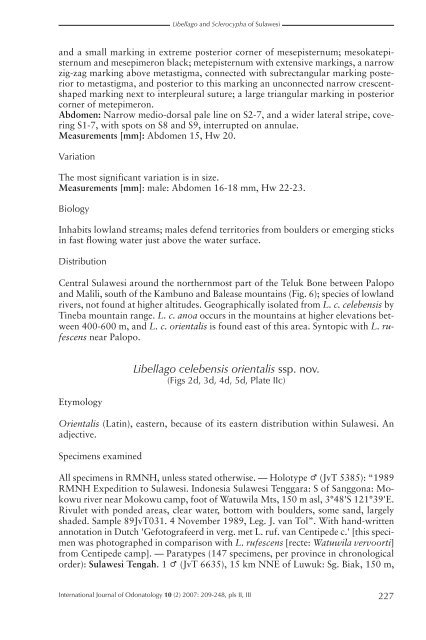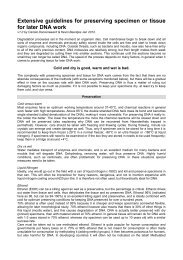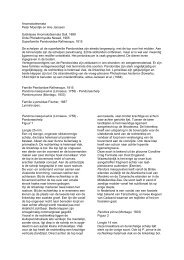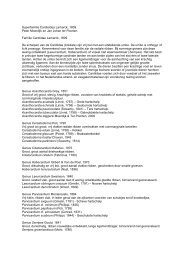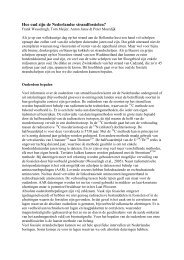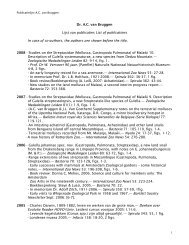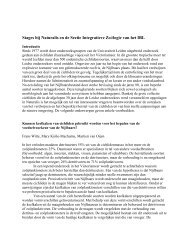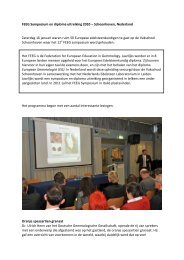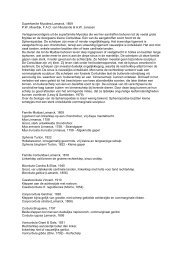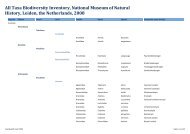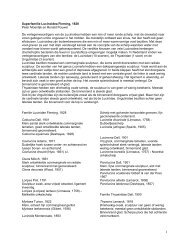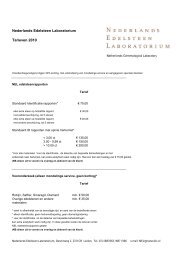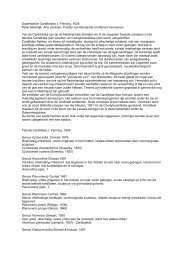The Odonata of Sulawesi and adjacent islands ... - science . naturalis
The Odonata of Sulawesi and adjacent islands ... - science . naturalis
The Odonata of Sulawesi and adjacent islands ... - science . naturalis
Create successful ePaper yourself
Turn your PDF publications into a flip-book with our unique Google optimized e-Paper software.
Libellago <strong>and</strong> Sclerocypha <strong>of</strong> <strong>Sulawesi</strong><br />
<strong>and</strong> a small marking in extreme posterior corner <strong>of</strong> mesepisternum; mesokatepisternum<br />
<strong>and</strong> mesepimeron black; metepisternum with extensive markings, a narrow<br />
zig-zag marking above metastigma, connected with subrectangular marking posterior<br />
to metastigma, <strong>and</strong> posterior to this marking an unconnected narrow crescentshaped<br />
marking next to interpleural suture; a large triangular marking in posterior<br />
corner <strong>of</strong> metepimeron.<br />
Abdomen: Narrow medio-dorsal pale line on S2-7, <strong>and</strong> a wider lateral stripe, covering<br />
S1-7, with spots on S8 <strong>and</strong> S9, interrupted on annulae.<br />
Measurements [mm]: Abdomen 15, Hw 20.<br />
Variation<br />
<strong>The</strong> most significant variation is in size.<br />
Measurements [mm]: male: Abdomen 16-18 mm, Hw 22-23.<br />
Biology<br />
Inhabits lowl<strong>and</strong> streams; males defend territories from boulders or emerging sticks<br />
in fast flowing water just above the water surface.<br />
Distribution<br />
Central <strong>Sulawesi</strong> around the northernmost part <strong>of</strong> the Teluk Bone between Palopo<br />
<strong>and</strong> Malili, south <strong>of</strong> the Kambuno <strong>and</strong> Balease mountains (Fig. 6); species <strong>of</strong> lowl<strong>and</strong><br />
rivers, not found at higher altitudes. Geographically isolated from L. c. celebensis by<br />
Tineba mountain range. L. c. anoa occurs in the mountains at higher elevations between<br />
400-600 m, <strong>and</strong> L. c. orientalis is found east <strong>of</strong> this area. Syntopic with L. rufescens<br />
near Palopo.<br />
Etymology<br />
Libellago celebensis orientalis ssp. nov.<br />
(Figs 2d, 3d, 4d, 5d, Plate IIc)<br />
Orientalis (Latin), eastern, because <strong>of</strong> its eastern distribution within <strong>Sulawesi</strong>. An<br />
adjective.<br />
Specimens examined<br />
All specimens in RMNH, unless stated otherwise. — Holotype P (JvT 5385): “1989<br />
RMNH Expedition to <strong>Sulawesi</strong>. Indonesia <strong>Sulawesi</strong> Tenggara: S <strong>of</strong> Sanggona: Mokowu<br />
river near Mokowu camp, foot <strong>of</strong> Watuwila Mts, 150 m asl, 3°48'S 121°39'E.<br />
Rivulet with ponded areas, clear water, bottom with boulders, some s<strong>and</strong>, largely<br />
shaded. Sample 89JvT031. 4 November 1989, Leg. J. van Tol”. With h<strong>and</strong>-written<br />
annotation in Dutch 'Gefotografeerd in verg. met L. ruf. van Centipede c.' [this speci -<br />
men was photographed in comparison with L. rufescens [recte: Watuwila vervoorti]<br />
from Centipede camp]. — Paratypes (147 specimens, per province in chronological<br />
order): <strong>Sulawesi</strong> Tengah. 1 P (JvT 6635), 15 km NNE <strong>of</strong> Luwuk: Sg. Biak, 150 m,<br />
International Journal <strong>of</strong> Odonatology 10 (2) 2007: 209-248, pls II, III<br />
227


